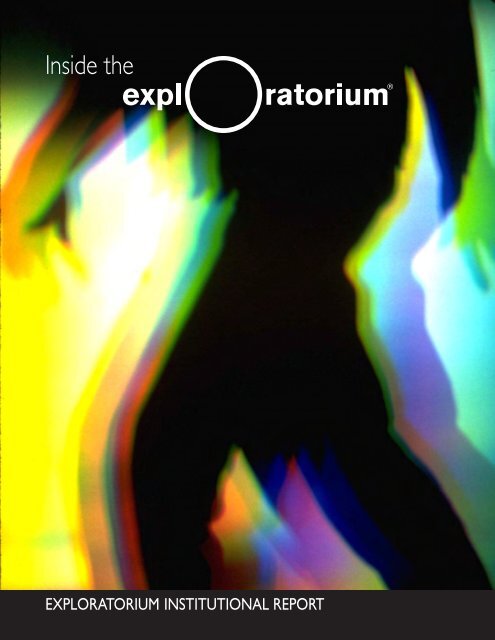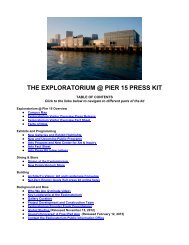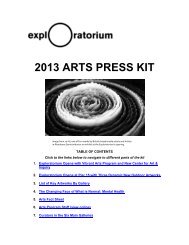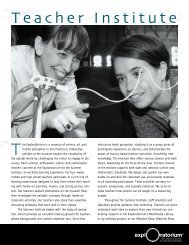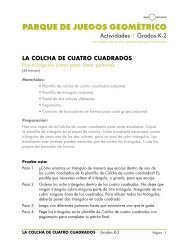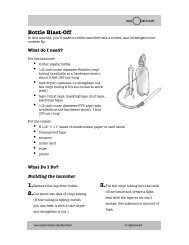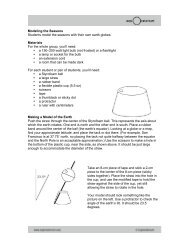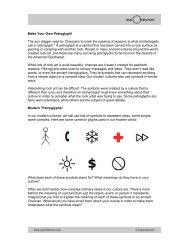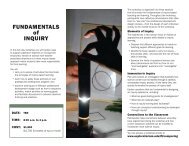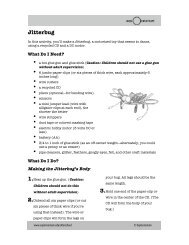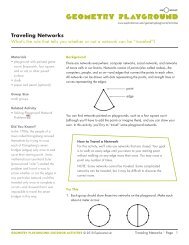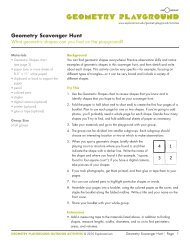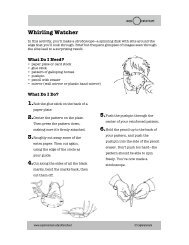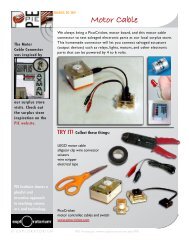Inside the - Exploratorium
Inside the - Exploratorium
Inside the - Exploratorium
You also want an ePaper? Increase the reach of your titles
YUMPU automatically turns print PDFs into web optimized ePapers that Google loves.
<strong>Inside</strong> <strong>the</strong><br />
EXPLORATORIUM INSTITUTIONAL REPORT<br />
www.exploratorium.edu
Contents<br />
www.exploratorium.edu<br />
PART 1: Welcome to <strong>the</strong> <strong>Exploratorium</strong> . . . . . . . . . . . . .3<br />
PART 2: Past, Present, and Future . . . . . . . . . . . . . . . . . . .7<br />
PART 3: A Museum Filled with Hundreds of<br />
Explore-for-Yourself Exhibits . . . . . . . . . . . . . . . . . . .11<br />
PART 4: An R&D Facility that Tests <strong>the</strong><br />
Boundaries of Informal Science Learning . . . . . . .14<br />
PART 5: An Interactive Environment for<br />
Science Education Research & Reform . . . . . . . . . .17<br />
PART 6: A Laboratory for Experimenting with<br />
Media & Communication . . . . . . . . . . . . . . . . . . . . . . . .19<br />
PART 7: A Staging Area for Creating and<br />
Experiencing <strong>the</strong> Arts . . . . . . . . . . . . . . . . . . . . . . . . . . . .23<br />
PART 8: A Community of People Sharing<br />
Ideas, Experience, & Expertise . . . . . . . . . . . . . . . . . .25<br />
PART 9: Facts, Figures, & Contact Information . . . . .29
Welcome to <strong>the</strong> <strong>Exploratorium</strong><br />
www.exploratorium.edu<br />
3<br />
San Francisco’s Palace of Fine Arts, <strong>the</strong> <strong>Exploratorium</strong>’s<br />
iconic home, is a masterpiece of quiet contemplation.<br />
Surrounded by stately homes, an elegant colonnade, an imposing<br />
rotunda, and neat garden paths that circle a reflective lagoon, you might<br />
expect <strong>the</strong> building to house an equally quiet, contemplative experience.<br />
But that’s not exactly <strong>the</strong> case. Open <strong>the</strong> doors and walk into <strong>the</strong><br />
<strong>Exploratorium</strong>, and a very different experience awaits.
Welcome<br />
www.exploratorium.edu<br />
4<br />
<strong>Inside</strong> is a cavernous space teeming with activity, its<br />
darkened interior exploding with <strong>the</strong> lights, sights, colors, and sounds<br />
of people experimenting with hundreds of explore-for-yourself<br />
exhibits.<br />
Wander in on a typical day, and you’ll find visitors taking <strong>the</strong>ir own<br />
personal journeys through a maze of interactive investigations or<br />
being towed by enthusiastic companions bent on <strong>the</strong>ir own mustplay<br />
destinations. Each exhibit <strong>the</strong>y stop at offers a new experience:<br />
Touch a tornado, see inside a live zebrafish egg, or maybe just<br />
consider <strong>the</strong> thought-provoking opportunity of taking a long, cool<br />
drink from a toilet-bowl fountain.<br />
SELF-GUIDED EXPLORATION<br />
There’s no right or wrong way to use an <strong>Exploratorium</strong> exhibit.<br />
While a researcher might use <strong>the</strong> Chaotic Pendulum exhibit to<br />
investigate complex systems, for example, a preschooler might get<br />
a kick out of just turning <strong>the</strong> knob to make <strong>the</strong> little man go—a<br />
rewarding accomplishment in itself when you’re five.
Welcome<br />
www.exploratorium.edu<br />
5<br />
Chances are, every nook and cranny of <strong>the</strong><br />
building is filled with activity. Look in <strong>the</strong> <strong>the</strong>ater and<br />
you’re likely to find films about shadows being screened, or<br />
perhaps <strong>the</strong>re’s a lecture-discussion on nanotechnology in<br />
session. Peek in through <strong>the</strong> windows of a classroom and you<br />
might see teachers building mini-exhibits for <strong>the</strong>ir students or<br />
experimenting on frozen spheres of water with food coloring,<br />
power tools, even condiments. (What happens when you<br />
pour sugar on an “ice balloon”? How about salt? Why <strong>the</strong><br />
difference?)<br />
It’s fascinating—and fun. But it’s a lot more than that. It’s also<br />
serious learning. Unlike <strong>the</strong> passive environment of knowledge<br />
transfer that is <strong>the</strong> hallmark of many traditional institutions,<br />
<strong>Exploratorium</strong> exhibits prompt active investigation. In fact,<br />
most of our exhibits don’t actually “do” anything unless<br />
someone takes <strong>the</strong> initiative to use <strong>the</strong>m. As a result, every<br />
visitor ends up having a distinctly personal experience.
Welcome<br />
www.exploratorium.edu<br />
6<br />
But <strong>the</strong> <strong>Exploratorium</strong> is much more than a<br />
collection of exhibits. In fact, what most people see<br />
when <strong>the</strong>y visit is just a small part of what <strong>the</strong> <strong>Exploratorium</strong><br />
is all about. Behind <strong>the</strong> scenes are youth-development efforts,<br />
homeschool and after-school programs, arts residencies, media<br />
experiments, teacher professional-development programs,<br />
informal education research, and much more.<br />
The <strong>Exploratorium</strong>’s reach goes far beyond <strong>the</strong> museum’s walls,<br />
transforming teacher practices, creating alternative educational<br />
experiences, developing institutional partnerships, networks,<br />
and online communities, and extending learning experiences to<br />
people all around <strong>the</strong> world. Our goal is to give people of all ages<br />
not just <strong>the</strong> tools but also <strong>the</strong> confidence <strong>the</strong>y need to become<br />
active investigators and explorers, helping <strong>the</strong>m let go of old,<br />
passive models of learning and see <strong>the</strong>mselves as active partners<br />
in <strong>the</strong> learning process.<br />
The prototype for <strong>the</strong> modern science center, <strong>the</strong> <strong>Exploratorium</strong><br />
is unique in its ability to forge new paths. It was <strong>the</strong> first museum<br />
to include artists in its exhibit-development process, <strong>the</strong> first<br />
museum to be established as a center for teacher professional<br />
development, and <strong>the</strong> first independent museum to have a<br />
website. Today, it’s <strong>the</strong> epicenter of world science centers,<br />
originating programs, exhibits, and experiences that reach<br />
millions of visitors around <strong>the</strong> globe.<br />
“Best Science Center<br />
in <strong>the</strong> World.”<br />
—4th Science Center World<br />
Congress, Rio de Janeiro
Past, Present, & Future<br />
www.exploratorium.edu<br />
A Brief History<br />
The <strong>Exploratorium</strong> opened to <strong>the</strong> public in <strong>the</strong> fall of 1969. Richard M. Nixon<br />
was president, and <strong>the</strong> Vietnam War and racial tensions continued to divide<br />
<strong>the</strong> nation. Neil Armstrong had just taken humankind’s first walk on <strong>the</strong> moon,<br />
Andy Warhol was creating pop-art images of soup cans, and <strong>the</strong> hot tub had<br />
just been introduced in California. More than 70 million children from <strong>the</strong><br />
post-war baby boom were becoming teenagers and young adults, and San<br />
Francisco had become a nexus for social experimentation. It was <strong>the</strong> perfect<br />
place—and <strong>the</strong> perfect time—to try out a new way of learning.<br />
Frank Oppenheimer, <strong>the</strong>n 57 years old, had already had three life-shaping<br />
careers before coming to San Francisco. A brilliant physicist in his own right,<br />
he’d been a university professor and worked beside his bro<strong>the</strong>r, J. Robert<br />
Oppenheimer (known to some as <strong>the</strong> “fa<strong>the</strong>r” of <strong>the</strong> atomic bomb), on <strong>the</strong><br />
Manhattan Project of <strong>the</strong> 1940s. Barred from pursuing scientific research<br />
during <strong>the</strong> McCarthy era of <strong>the</strong> 1950s, Frank retreated to small-town<br />
Colorado and became a cattle rancher. Before long, his passion for knowledge<br />
and learning led him back to teaching, and he began to share his view of <strong>the</strong><br />
world with students at <strong>the</strong> local high school.<br />
Considering <strong>the</strong> richness of his own life experiences, Frank was no typical<br />
science teacher. He put down <strong>the</strong> textbook and filled his classroom with <strong>the</strong><br />
hands-on tools and materials that had become his trademark and that would<br />
ultimately lead him to create <strong>the</strong> <strong>Exploratorium</strong>. In 1969, Frank’s dream of<br />
transforming science education brought him to San Francisco and to <strong>the</strong><br />
cavernous—and very empty—Palace of Fine Arts.<br />
Frank poured heart and soul into his “San Francisco Project,” working<br />
alongside <strong>the</strong> artists, educators, and developers whose job it was to build and<br />
maintain <strong>Exploratorium</strong> exhibits and help visitors use <strong>the</strong>m. He served as <strong>the</strong><br />
museum’s director until just before his death in 1985.<br />
7<br />
The <strong>Exploratorium</strong> grew enormously<br />
during <strong>the</strong> 1980s, continuing <strong>the</strong> work<br />
Frank set in motion. After a series of acting<br />
directors, Dr. Robert L. White, Chairman of<br />
Stanford University’s Electrical Engineering<br />
Department, directed <strong>the</strong> institution from<br />
1987 to 1990. In 1991, renowned French<br />
physicist and educator Goéry Delacôte<br />
joined, serving as Executive Director<br />
until 2005. Dr. Delacôte worked toward<br />
extending <strong>the</strong> reach of <strong>the</strong> museum,<br />
expanding teacher-development programs,<br />
creating a robust Web presence, and<br />
supporting <strong>the</strong> formation of partnerships<br />
worldwide.
Past, Present, & Future<br />
CHANGING HOW THE WORLD LEARNS<br />
At <strong>the</strong> <strong>Exploratorium</strong>, giving visitors control of <strong>the</strong>ir experience<br />
gives <strong>the</strong>m <strong>the</strong> opportunity to exercise <strong>the</strong>ir own curiosity, insight,<br />
and creativity, breaking down barriers that can make learning science<br />
a daunting experience. People come away with valuable tools for<br />
understanding <strong>the</strong> world around <strong>the</strong>m and <strong>the</strong> confidence to apply<br />
<strong>the</strong>m, rarely noticing that <strong>the</strong>y’ve actually learned by having fun.<br />
www.exploratorium.edu<br />
Today...<br />
Today <strong>the</strong> <strong>Exploratorium</strong> is led by Dr. Dennis Bartels, a nationally known<br />
science-education and policy expert dedicated to streng<strong>the</strong>ning <strong>the</strong><br />
<strong>Exploratorium</strong>’s culture of lifelong learning. Under his guidance, <strong>the</strong> museum<br />
has begun a new phase of growth and exploration.<br />
With a goal of impacting policy throughout <strong>the</strong> country, programs have been<br />
designed to make connections between <strong>the</strong> traditionally separate worlds of<br />
education in formal and informal environments: connecting <strong>the</strong> way science<br />
is taught in schools with <strong>the</strong> way it’s approached in science centers; making<br />
rarely seen scientific research accessible to <strong>the</strong> public; providing a venue for<br />
experimental artists to interact directly with live audiences.<br />
Over <strong>the</strong> past few years, <strong>Exploratorium</strong> staff have pioneered innovative ways<br />
to make <strong>the</strong>se connections, working with researchers at <strong>the</strong> South Pole,<br />
NASA scientists studying <strong>the</strong> atmosphere of <strong>the</strong> sun, playground designers<br />
creating immersive experiences for children, even Tibetan monks investigating<br />
<strong>the</strong> philosophic underpinnings of scientific phenomena.<br />
8
Past, Present, & Future<br />
www.exploratorium.edu<br />
9<br />
...and Tomorrow<br />
While <strong>the</strong> <strong>Exploratorium</strong>’s philosophy remains <strong>the</strong> same, its scope<br />
of work has grown enormously over <strong>the</strong> years. Staff, programs,<br />
and facilities filled up <strong>the</strong> physical space at <strong>the</strong> Palace of Fine Arts<br />
long ago, spreading out not just to multiple buildings on <strong>the</strong> nearby<br />
Presidio, but even into <strong>the</strong> hollow legs of <strong>the</strong> rotunda that fronts<br />
<strong>the</strong> adjacent lagoon.<br />
Right now, <strong>the</strong> <strong>Exploratorium</strong> is an explosive force being held in by<br />
too-small walls. But we’ve got our sights set on a future that will<br />
see us well on our way to setting and achieving new goals for <strong>the</strong><br />
21st century. We hope you’ll come along for <strong>the</strong> ride.
Past, Present, & Future<br />
TRANSFORMATIONS IN LEARNING<br />
More than forty years after Frank<br />
Oppenheimer began his “<strong>Exploratorium</strong><br />
experiment,” hundreds of science<br />
centers worldwide have embraced <strong>the</strong><br />
<strong>Exploratorium</strong>’s approach to learning by<br />
doing. By making science visible, touchable,<br />
and accessible to people of every age and<br />
description, <strong>the</strong> <strong>Exploratorium</strong>’s experiential<br />
approach has impacted science education<br />
worldwide and influenced people around<br />
<strong>the</strong> globe.<br />
www.exploratorium.edu<br />
10<br />
Impact<br />
Today, it’s easy to take for granted <strong>the</strong> innovations pioneered during <strong>the</strong><br />
institution’s early days, but in <strong>the</strong> 1960s, <strong>the</strong> idea of offering interactive<br />
science explorations in a public setting ran counter to <strong>the</strong> accepted<br />
model of what a “museum” even was. Frank’s experiment was so<br />
different that not only did he need a new term to describe <strong>the</strong> place<br />
itself (an “<strong>Exploratorium</strong>”), he even needed people to model its use.<br />
From <strong>the</strong> beginning, <strong>the</strong> museum’s young Explainers didn’t explain <strong>the</strong><br />
science behind <strong>the</strong> exhibits as much as <strong>the</strong>y encouraged visitors to feel<br />
comfortable using <strong>the</strong> exhibits, since “please touch” was not a familiar<br />
way to behave in a science museum.<br />
The Explainer Program, now replicated around <strong>the</strong> world, was just <strong>the</strong><br />
first in a long line of innovative programs that had <strong>the</strong>ir start at <strong>the</strong><br />
<strong>Exploratorium</strong>. By adding artists and educators to its staff of scientists<br />
and exhibit developers, <strong>the</strong> institution began creating experiences<br />
that were unique among science centers. Soon Frank, who believed in<br />
sharing ra<strong>the</strong>r than holding on to knowledge, was conducting tours<br />
of <strong>the</strong> new <strong>Exploratorium</strong>, and <strong>Exploratorium</strong>-developed innovations<br />
and exhibits began to be adopted by museums from Boston to Beijing.<br />
It’s been estimated that, to date, more than 145 million people around<br />
<strong>the</strong> world have interacted with <strong>Exploratorium</strong>-designed programs and<br />
exhibits.<br />
Today, <strong>the</strong> <strong>Exploratorium</strong> is an “only in San Francisco” experience that<br />
reflects <strong>the</strong> city’s exciting, experiential character. But on an international<br />
scale, it’s acknowledged as a unique evolutionary force, redefining <strong>the</strong><br />
role of <strong>the</strong> science center and revolutionizing science education for<br />
both children and adults worldwide.
A Museum Filled with Hundreds of Explore-for-Yourself Exhibits<br />
www.exploratorium.edu<br />
11<br />
Exhibits<br />
Exhibits and Core Collections<br />
It’s often been said that <strong>the</strong> <strong>Exploratorium</strong>’s first<br />
“official” visitors wandered in one day when founder<br />
Frank Oppenheimer forgot to lock <strong>the</strong> museum doors behind him.<br />
Whe<strong>the</strong>r or not <strong>the</strong> story is true (and it probably is), it’s typical of <strong>the</strong><br />
<strong>Exploratorium</strong>’s ethos and culture.<br />
The <strong>Exploratorium</strong> wasn’t finished when it opened, and it isn’t finished<br />
now. In fact, <strong>Exploratorium</strong> exhibits—built by <strong>the</strong> museum’s own<br />
staff of scientists, artists, tinkerers, and thinkers, or by visiting artists<br />
and collaborators—are never considered done. They’re “working<br />
prototypes,” subject to continuous evaluation, change, update, rework,<br />
or replacement. Some of <strong>the</strong> first exhibits created for <strong>the</strong> museum<br />
are still available for visitors to explore. O<strong>the</strong>rs have come and gone,<br />
and still o<strong>the</strong>rs have evolved through <strong>the</strong> years, transforming with each<br />
iteration.<br />
By focusing primarily on natural phenomena, <strong>the</strong> museum’s exhibit<br />
collections offer insight into <strong>the</strong> basics of scientific understanding. Core<br />
collections provide overarching, yet flexible structures for <strong>the</strong> museum’s<br />
curriculum and organization.
Explore-for-Yourself Exhibits<br />
TEMPORARY EXHIBITIONS<br />
From time to time, <strong>the</strong> <strong>Exploratorium</strong><br />
enhances its collections<br />
with both long- and short-term<br />
temporary exhibitions. Some are<br />
brought in from outside venues,<br />
but most are conceived, built, and/<br />
or curated by museum staff—<br />
including “Reflections” (2009) and<br />
“Geometry Playground” (2010).<br />
www.exploratorium.edu<br />
12<br />
Core Collections<br />
Exhibits and Core Collections<br />
SEEING presents illuminating insights into <strong>the</strong> complex processes of<br />
interpreting <strong>the</strong> world through eye, brain, and experience.<br />
TRAITS OF LIFE investigates <strong>the</strong> riotous diversity of life, exploring its<br />
underlying unity with unique exhibits and demonstrations.<br />
WORLD OF MATTER exhibits on electricity, heat and temperature,<br />
motion, and complexity, give visitors a close-up look at <strong>the</strong> “stuff” our<br />
world is made of.<br />
LISTEN gives visitors <strong>the</strong> opportunity to examine how, what, and why<br />
<strong>the</strong>y hear what <strong>the</strong>y hear.<br />
MIND asks visitors to think about <strong>the</strong> workings of <strong>the</strong> mind—from<br />
how we make judgments and decisions to consciousness, belief, and<br />
understanding.<br />
OUTDOOR EXPLORATORIUM—a collection of experimental<br />
exhibits installed along <strong>the</strong> waterfront at nearby Fort Mason—offers<br />
interactive explorations of San Francisco Bay.
Explore-for-Yourself Exhibits<br />
www.exploratorium.edu<br />
Visitor Experience/Research<br />
The <strong>Exploratorium</strong>’s Visitor Research and Evaluation department studies<br />
<strong>the</strong> use and effectiveness of our exhibit collections and practices, as well as<br />
<strong>the</strong> impact of informal learning on <strong>the</strong> museum floor. Not only does <strong>the</strong>ir<br />
work help improve <strong>Exploratorium</strong> exhibits and programs, <strong>the</strong> books, reports,<br />
and studies <strong>the</strong>y undertake also inform <strong>the</strong> museum field worldwide. Since<br />
<strong>the</strong> group’s inception in 1996, visitor research and evaluation efforts have<br />
become an integral part of <strong>the</strong> museum’s exhibit design and development<br />
process.<br />
13<br />
BUILDING SCIENCE ON SITE<br />
<strong>Exploratorium</strong> exhibits are built on-site and by museum staff. Our opento-view<br />
Machine Shop—itself considered a seminal exhibit—lets visitors<br />
watch scientists, artists, educators, and exhibit developers at work.
An R&D Facility that Tests <strong>the</strong> Boundaries of Informal Science Learning<br />
“I have invested in this place over <strong>the</strong><br />
years. Why? Because I know its value. The<br />
<strong>Exploratorium</strong> is priceless in <strong>the</strong> education<br />
of our young people. In fact, it’s priceless<br />
in <strong>the</strong> education of just about everybody.”<br />
www.exploratorium.edu<br />
—William Hewlett<br />
Co-founder, Hewlett-Packard Company<br />
14<br />
Lifelong Learning Programs<br />
Educational Outreach: Educational Outreach links <strong>the</strong><br />
<strong>Exploratorium</strong> with community-based organizations serving<br />
inner-city children, teens, and families throughout <strong>the</strong> San<br />
Francisco Bay Area. Services to schools, community centers,<br />
children’s hospitals, and after-school programs are provided<br />
free of charge and give at-risk and underserved children <strong>the</strong><br />
opportunity to use simple tools and hands-on materials to do<br />
everything from wiring circuits to creating homemade musical<br />
instruments. The program also provides free educational<br />
materials, professional-development workshops, and access to<br />
<strong>Exploratorium</strong> resources. Selected middle- and high-schoolaged<br />
students participate in technology programs during<br />
intensive summer sessions and during out-of-school time<br />
throughout <strong>the</strong> year.<br />
School Field Trips: Each year, thousands of school groups<br />
visit <strong>the</strong> <strong>Exploratorium</strong> on field trips. The <strong>Exploratorium</strong>’s<br />
unique laboratory setting offers opportunities rarely available<br />
in schools for science learning. Additional resources to support<br />
teachers before, during, and after field trips are available online.
Informal Science Learning<br />
www.exploratorium.edu<br />
15<br />
Lifelong Learning Programs<br />
Day Camps: At <strong>the</strong> <strong>Exploratorium</strong>, day camps are available yearround.<br />
Designed for children ages 5–14, programs offer a combination<br />
of fun group activities, free time with exhibits, outdoor explorations,<br />
and one-on-one time with museum educators. Summer Camp, weekend<br />
camps, Winter Break Camp, and Spring Break Camp fill out <strong>the</strong> year.<br />
Family Workshops and Excursions: For families looking for<br />
something special to do toge<strong>the</strong>r on <strong>the</strong> weekend, <strong>the</strong> <strong>Exploratorium</strong><br />
offers a variety of exciting workshops and excursions, from bicycle<br />
outings to Fort Mason to discovering magnetic “black sand” at Ocean<br />
Beach. These engaging and innovative experiences give family members<br />
a chance to play—and learn—toge<strong>the</strong>r.
Informal Science Learning<br />
www.exploratorium.edu<br />
16<br />
Lifelong Learning Programs<br />
Homeschool Science Workshops: In this popular program, parents<br />
and children toge<strong>the</strong>r explore key science and human perception<br />
concepts through a combination of guided inquiry, exhibit exploration,<br />
and in-depth classroom activities. These workshops give students ages<br />
6–12 <strong>the</strong> opportunity to work with one ano<strong>the</strong>r in a safe social setting,<br />
and parents get to share <strong>the</strong>ir own experiences with one ano<strong>the</strong>r.<br />
Adult Discussion Groups, Workshops, and Excursions: New<br />
program formats to meet <strong>the</strong> needs of adults are under development,<br />
including a series on Sustainable Architecture, with behind-<strong>the</strong>-scenes<br />
access to local green buildings and <strong>the</strong> experts who made <strong>the</strong>m.<br />
“Since its inception, San<br />
Francisco’s <strong>Exploratorium</strong><br />
has set <strong>the</strong> standard for<br />
experiential approaches to<br />
learning.”<br />
—Howard Gardner,<br />
Hobbs Professor of Cognition<br />
and Education, Harvard Graduate<br />
School of Education
An Interactive Environment for Science Education Research & Reform<br />
www.exploratorium.edu<br />
Teacher Professional-Development Programs<br />
17<br />
Teacher Institute: Celebrating its 25th anniversary in<br />
2009, <strong>the</strong> Teacher Institute is a professional home for more<br />
than two thousand middle and high school science and math<br />
teachers who have formed a unique community dedicated<br />
to sharing and exploring information, activities, and teaching<br />
strategies. The Teacher Institute’s support is career-long and<br />
includes formal programs for novice, mid-career, and veteran<br />
teachers. In <strong>the</strong>se programs, teachers mentor one ano<strong>the</strong>r,<br />
attend summer institutes toge<strong>the</strong>r, share ideas in online<br />
forums, develop hands-on activities and innovative lessons,<br />
experiment with new technologies, and more.<br />
Institute for Inquiry: The Institute for Inquiry, which<br />
began its life more than 30 years ago as <strong>the</strong> original “School<br />
in <strong>the</strong> <strong>Exploratorium</strong>,” has evolved into a highly soughtafter<br />
professional-development program focusing on inquiry<br />
methods of teaching and learning. Today, <strong>the</strong> Institute for<br />
Inquiry provides workshops and online resources for a<br />
national and international community of K–5 education<br />
reform leaders and school districts. Institute for Inquiry staff<br />
also work with teachers, professional developers, school<br />
administrators, and university educators interested in<br />
exploring <strong>the</strong> <strong>the</strong>ory and practice of creating inquiry-based<br />
experiences in <strong>the</strong> classroom.
Science Education Research & Reform<br />
www.exploratorium.edu<br />
18<br />
Explainer Programs<br />
High School Explainer Program: In this work-based learning<br />
program, high-school-aged students from a wide variety of cultures<br />
and backgrounds are brought toge<strong>the</strong>r to support general museum<br />
operations. The program combines on-<strong>the</strong>-job experience and<br />
academic instruction to encourage students to explore, teach, and<br />
learn. For most, this is a first paid position, and so brings additional<br />
responsibilities of personal and professional growth. With continuing<br />
support and training by program staff (all of whom are graduate<br />
Explainers) and <strong>Exploratorium</strong> scientists and educators, <strong>the</strong> program<br />
is a valuable formative experience for young men and women.<br />
Field Trip Explainer Program: Field Trip Explainers are<br />
educators who work with students visiting <strong>the</strong> <strong>Exploratorium</strong> on<br />
school field trips. They support <strong>the</strong> goals of <strong>the</strong>se visiting groups<br />
and work to ensure a positive and rich experience, facilitating<br />
demonstrations, giving orientations, and interacting with students<br />
at exhibits on <strong>the</strong> museum floor. Field Trip Explainers are diverse in<br />
<strong>the</strong>ir academic, professional, and life experiences; what <strong>the</strong>y have in<br />
common is a love of working with kids and an interest in developing<br />
<strong>the</strong>ir professional skills. Field Trip Explainers also help out staff during<br />
special events and lend <strong>the</strong>ir talents to a variety of museum projects<br />
and programs.<br />
“When you get to come<br />
and try to do gravity<br />
yourself, it makes it<br />
funner. That’s <strong>the</strong> way<br />
I see it.”<br />
—Ceondra P., age 14
A Laboratory for Experimenting with Media & Communication<br />
www.exploratorium.edu<br />
19<br />
Online Communication<br />
Website: Making its debut in 1993, <strong>the</strong> <strong>Exploratorium</strong> was <strong>the</strong> first<br />
independent museum to have a site on <strong>the</strong> World Wide Web. Today,<br />
our online presence encompasses more than 25,000 pages of content,<br />
and continues to grow every day. With everything from information,<br />
educational activities, and blogs, to Web-based arts and exhibitions,<br />
<strong>the</strong> site is an extension of <strong>the</strong> explorations and experiences on <strong>the</strong><br />
museum’s floor. Among its many honors, <strong>the</strong> <strong>Exploratorium</strong>’s website<br />
has received Webby Awards for Best Science Site and Best Education<br />
Site a total of five times since 1997. An online destination for visitors,<br />
educators, museum professionals, and people around <strong>the</strong> globe, it’s<br />
one of <strong>the</strong> most visited museum sites in <strong>the</strong> world, serving 20 million<br />
visitors each year.<br />
THE EXPLORATORIUM IN CYBERSPACE<br />
<strong>Exploratorium</strong> staff are always experimenting with new ways to interact<br />
in cyberspace—from <strong>the</strong> virtual world of Second Life to <strong>the</strong> online<br />
social-media communities of Facebook, Twitter, MySpace, and more.
Media & Communication<br />
www.exploratorium.edu<br />
20<br />
Media Resources<br />
Learning Commons: The museum’s traditional library has undergone<br />
a makeover and name change, reflecting trends in small-group<br />
collaborative learning and access to media tools. The facility serves<br />
educators who are alumni of our professional-development programs,<br />
as well as staff. Efforts to digitally archive <strong>the</strong> <strong>Exploratorium</strong>’s legacy of<br />
content development for preservation and access are centered in <strong>the</strong><br />
Learning Commons.<br />
Media Archives: Our archivists have undertaken <strong>the</strong> gargantuan task<br />
of digitizing more than forty years’ worth of media originating in every<br />
imaginable format. The audio, video, image, print, and even online files<br />
that have been saved—and <strong>the</strong>re are thousands still to be processed—<br />
give us unprecedented access to records that span <strong>the</strong> decades,<br />
showing <strong>the</strong> beginnings of <strong>the</strong> <strong>Exploratorium</strong>, its growth and evolution,<br />
and its current focus and goals. Images from <strong>the</strong> museum’s early years<br />
and content from past events and exhibitions have been found and<br />
restored. Hundreds of forgotten video and audio recordings have also<br />
been rescued by <strong>the</strong>se efforts, revealing <strong>the</strong> formative work and ideas<br />
of now-prominent artists, scientists, and musicians who have visited <strong>the</strong><br />
<strong>Exploratorium</strong>.<br />
“We cannot go on in a society<br />
like this, having so many people<br />
essentially ignorant of science....<br />
They have to be told about<br />
science in <strong>the</strong> right way, and<br />
that’s where <strong>the</strong> <strong>Exploratorium</strong><br />
comes in.”<br />
—Dr. Francis Crick<br />
Nobel Laureate and co-discoverer<br />
of <strong>the</strong> structure of DNA
Media & Communication<br />
www.exploratorium.edu<br />
“No one in recent years<br />
has had a greater impact<br />
upon museums.”<br />
21<br />
Media Resources<br />
Photography: With unique access to <strong>the</strong> phenomena of science, our<br />
extensive photo collection is a goldmine of unusual and imaginative<br />
imagery. Thousands of photos document everything from <strong>the</strong><br />
excitement of special events to <strong>the</strong> intensity of <strong>the</strong> creative process<br />
to <strong>the</strong> elegance of <strong>the</strong> effects revealed by <strong>the</strong> museum’s artworks and<br />
exhibits.<br />
Moving Images: Our Moving Images staff documents <strong>the</strong> sights and<br />
sounds of <strong>Exploratorium</strong> programs, both at home and abroad. Our<br />
state-of-<strong>the</strong>-art Phyllis C. Wattis Webcast Studio is home to innovative<br />
programming that brings compelling explorations in <strong>the</strong> arts and<br />
sciences live and via <strong>the</strong> Internet to individuals, schools, and institutions<br />
worldwide. Live and archived videos, webcasts, and podcasts created for<br />
programs museumwide are available online at www.explo.tv.<br />
—American Association<br />
of Museums Award to<br />
<strong>Exploratorium</strong> Founder<br />
Dr. Frank Oppenheimer
Media & Communication<br />
www.exploratorium.edu<br />
explore<br />
July/August/September 2009<br />
In this issue: Maker Faire, Into <strong>the</strong> Looking Glass, It’s All Done with Mirrors, What’s in Store?, Museum News, and more!<br />
www.exploratorium.edu<br />
22<br />
Media Resources<br />
Print Publications: With sales of 40,000 copies of <strong>Exploratorium</strong>developed<br />
publications each year, our Learning Tools program is<br />
dedicated to sharing innovative ideas in teaching and learning and<br />
bringing hands-on activities to teachers, students, and families. In 2006,<br />
our award-winning book Exploratopia (Little Brown and Company)<br />
brought more than 400 kid-friendly experiments to families and<br />
classrooms and continues to provide a foundation for online offerings<br />
and on-site events. In 2009, twenty-five years after its introduction, <strong>the</strong><br />
<strong>Exploratorium</strong> Science Snackbook was re-envisioned and republished<br />
(Jossey-Bass/Wiley), providing instructions for making more than 100<br />
classroom-sized exhibits from everyday materials and giving teachers<br />
new ways to offer hands-on science in even <strong>the</strong> most challenging<br />
of environments. Journal articles, monographs, and books produced<br />
and disseminated to <strong>the</strong> informal science education field share <strong>the</strong><br />
<strong>Exploratorium</strong>’s philosophy and lessons learned and contribute to <strong>the</strong><br />
professional knowledge base of informal learning institutions worldwide.
A Staging Area for Creating & Experiencing <strong>the</strong> Arts<br />
www.exploratorium.edu<br />
23<br />
Arts Programs: <strong>Exploratorium</strong> Founder Frank Oppenheimer<br />
considered science and art complementary ways of seeing <strong>the</strong><br />
world and fostered <strong>the</strong> arts as part of <strong>the</strong> museum’s vision and<br />
development—a pioneering concept that has been woven into <strong>the</strong><br />
fabric of <strong>the</strong> institution. Over <strong>the</strong> years, hundreds of artists working<br />
in every imaginable discipline, both on-staff and through our artistsin-residence<br />
programs, have enlivened <strong>the</strong> museum floor, creating<br />
original installations and performances, engaging in experimentation<br />
and research, and developing new directions for <strong>the</strong>ir work. Today, <strong>the</strong><br />
<strong>Exploratorium</strong>’s program is considered a model for museums around<br />
<strong>the</strong> world, and several former staff members and artists-in-residence<br />
have been awarded MacArthur Fellowship “genius grants.”
Creating & Experiencing <strong>the</strong> Arts<br />
www.exploratorium.edu<br />
PODCASTS<br />
The <strong>Exploratorium</strong> has a long history<br />
with music, film, and performance arts,<br />
serving as a unique venue for such<br />
performers as Laurie Anderson, John<br />
Cage, Phillip Glass, Steve Reich, Brian<br />
Eno, and Trimpin, among o<strong>the</strong>rs.<br />
24<br />
Public Programs: Public programs animate <strong>the</strong> <strong>Exploratorium</strong> with<br />
innovative events, activities, and experiences, from original plays and<br />
artists’ presentations to crafts demonstrations and lecture-discussions.<br />
Programs might complement new exhibitions, address social issues,<br />
make current events in art and science available to <strong>the</strong> public, feature<br />
cutting-edge technologies, or just focus on <strong>the</strong> fun of seeing things<br />
from a new, and possibly unexpected, point of view. Our new After<br />
Dark series—special evening events for adults—totally transforms <strong>the</strong><br />
museum on <strong>the</strong> first Thursday of every month.<br />
Cinema Arts: The magic of <strong>the</strong> moving picture marries <strong>the</strong> arts<br />
and sciences with everything from sound and image to technique and<br />
technology, and all of those realms are explored by <strong>the</strong> <strong>Exploratorium</strong>’s<br />
Cinema Arts Program. Screenings, art installations, workshops, and oneon-one<br />
interactions with visiting artists and filmmakers give visitors <strong>the</strong><br />
opportunity to explore compelling alternative films through stories and<br />
evocative images about people, places, and ideas that extend beyond <strong>the</strong><br />
museum’s walls.
A Community of People Sharing Ideas, Experience, & Expertise<br />
www.exploratorium.edu<br />
25<br />
Learning Networks: The Learning Networks group works with<br />
outside collaborators to build knowledge and practice about science<br />
learning in informal settings. Projects spanning research, public programs,<br />
and professional development stress <strong>the</strong> role of imagination, creativity,<br />
and aes<strong>the</strong>tics for designing experiences that engage participants<br />
with natural and social phenomena. Current projects include <strong>the</strong><br />
technology-rich investigations of <strong>the</strong> PIE (Play, Invent, Explore) program,<br />
research conducted by <strong>the</strong> Center for Informal Learning and Schools,<br />
a partnership with <strong>the</strong> National Oceanic and Atmospheric Association<br />
(NOAA), and professional-development workshops that integrate<br />
research and practice for educators from informal-learning organizations<br />
worldwide.<br />
“<strong>Exploratorium</strong><br />
influences science<br />
museums new<br />
and old.”<br />
—Physics Today magazine
Sharing Ideas, Experience, & Expertise<br />
www.exploratorium.edu<br />
26<br />
“Anyone who has ever...visited<br />
any of <strong>the</strong> world’s three hundred<br />
interactive science and technology<br />
centers has indirectly experienced<br />
<strong>the</strong> power of <strong>the</strong> <strong>Exploratorium</strong>.”<br />
EXPLORATORIUM EXHIBIT NETWORK<br />
The San Francisco <strong>Exploratorium</strong> has partnerships and exhibits worldwide.<br />
PARTNER MUSEUMS OTHER EXHIBIT LOCATIONS <br />
INTERNATIONAL<br />
Ciencia Viva<br />
— Lisbon, Portugal<br />
Explor@dome<br />
— Paris, France<br />
Phæno<br />
— Wolfsburg, Germany<br />
Museo de las Ciencia<br />
— Valencia Spain<br />
Museo Interactivo Mirador<br />
— Santiago, Chile<br />
Sony Explora Science<br />
— Beijing, China<br />
Sony Explora Science<br />
— Tokyo, Japan<br />
www.exploratorium.edu<br />
U.S.A. (EXNET)<br />
Discovery Center<br />
—Springfield MO<br />
Don Harrington Discovery<br />
Center — Amarillo, TX<br />
Fort Worth Museum of<br />
Science and History—TX<br />
GWIZ — Sarasota FL<br />
Idea Place<br />
— Ruston LA<br />
Science Museum Oklahoma<br />
—Oklahoma City, OK<br />
Reuben H. Fleet Science<br />
Center — San Diego, CA<br />
SpectrUM— Missoula MT<br />
INTERNATIONAL<br />
Bangkok, Thailand<br />
Belfast, Ireland<br />
Bogota, Columbia<br />
Bremen, Germany<br />
Brest Cédex, France<br />
Bristol, England<br />
Budapest, Hungary<br />
Calgary, Canada<br />
Canberra, Australia<br />
Cape Town, South Africa<br />
Guatemala<br />
Hamilton, Bermuda<br />
Hellerup, Denmark<br />
Kobe, Japan<br />
Kuwait, Kuwait<br />
Lisbon, Portugal<br />
Mechelen, Belgium<br />
Mexicali, Mexico<br />
Mexico City, Mexico<br />
Moscow, Russia<br />
Osaka, Japan<br />
Paris, France<br />
Qanater, Egypt<br />
Rehovot, Israel<br />
Riyadh, Saudi Arabia<br />
Ro<strong>the</strong>rham, England<br />
Saitama, Japan<br />
San Sebastian, Spain<br />
Seoul, Korea<br />
Singapore, Singapore<br />
Taksim, Turkey<br />
Taichung, Taiwan<br />
Tokyo, Japan<br />
Toronto, Canada<br />
Trieste, Italy<br />
Vancouver, Canada<br />
ExNet Partnerships: The <strong>Exploratorium</strong> Network for Exhibit-Based<br />
Teaching (ExNET) combines exhibit and teaching programs that share<br />
<strong>the</strong> fruits of <strong>the</strong> <strong>Exploratorium</strong>’s exhibit development and education<br />
efforts with a diverse group of science-rich institutions around <strong>the</strong><br />
United States and <strong>the</strong> world. Each year, teams of exhibit developers and<br />
educators travel to partner museums around <strong>the</strong> globe, bringing our<br />
exhibits to a worldwide audience—and bringing new ideas and points of<br />
view back with <strong>the</strong>m to <strong>the</strong> <strong>Exploratorium</strong>.<br />
U.S.A.<br />
Atlanta, GA<br />
Aurora, IL<br />
Baltimore, MD<br />
Be<strong>the</strong>sda, MD<br />
Bettendorf, IA<br />
Birmingham, AL<br />
Boulder, CO<br />
Bozeman, MT<br />
Burbank, CA<br />
Charlotte, NC<br />
Cleveland, OH<br />
Dallas, TX<br />
Detroit, MI<br />
Kansas City, MO<br />
Kona, HI<br />
Lakeville, CT<br />
Little Rock, AR<br />
Livingston, LA<br />
Lubbock, TX<br />
New York, NY<br />
Norfolk, VA<br />
North Conway, NH<br />
Oakland, CA<br />
Orlando,FL<br />
Philadelphia, PA<br />
Phoenix, AZ<br />
Plano, TX<br />
—Forces for Good, 2007<br />
2009<br />
Roanoke, VA<br />
Rocky Mount, NC<br />
San Francisco, CA<br />
San Jose, CA<br />
Santa Ana, CA<br />
Seattle, WA<br />
Simi Valley, CA<br />
Sioux Falls, SD<br />
St. Paul, MN<br />
Walnut Creek, CA<br />
Wichita, KS<br />
Wichita Falls, TX<br />
Willamette, OR
Sharing Ideas, Experience, & Expertise<br />
Osher Fellows Program: Through an endowment from <strong>the</strong> Bernard<br />
Osher Foundation, <strong>the</strong> <strong>Exploratorium</strong> has established a fellowship<br />
program that welcomes four to six outstanding individuals from <strong>the</strong><br />
arts, sciences, and humanities for month-long residencies each year.<br />
Fellows work in <strong>the</strong> museum and with <strong>Exploratorium</strong> staff to help<br />
launch new ideas for education programs and exhibit projects and<br />
contribute <strong>the</strong>ir expertise to inform ongoing activities.<br />
www.exploratorium.edu<br />
27<br />
Strategic Alliances & Partnerships<br />
1969–Present<br />
Aim High<br />
American Association for <strong>the</strong> Advancement of Science (AAAS)<br />
Association of Science Technology Centers (ASTC)<br />
Boston Museum of Science<br />
Boys and Girls Clubs<br />
California School Age Consortium (CalSAC)<br />
Children’s Hospital Oakland<br />
Children’s Aid Society<br />
City College<br />
Coalition for Science After School<br />
Discovery Center of Springfield<br />
Fort Worth Museum of Science and History<br />
Fresno Metropolitan Museum<br />
G.WIZ, <strong>the</strong> Hands-On Science Museum<br />
Girl Scouts of San Francisco Bay Area<br />
Home Instructional Program for Preschool Youngsters (HIPPY)<br />
King’s College London<br />
Lawrence Hall of Science<br />
Los Angeles Unified School District and California Science Center<br />
Maker Faire<br />
Ma<strong>the</strong>matics Engineering Science Achievement (MESA)<br />
Massachusetts Institute of Technology (MIT) Media Lab<br />
NASA–Sun Earth Connection Education Forum<br />
NASA/JPL Museum Alliance<br />
National AfterSchool Association<br />
National Oceanic and Atmospheric Association (NOAA)<br />
Omniplex Science Museum<br />
Project Read San Francisco<br />
Rainbow Seventh Day Adventist Church<br />
Reuben H. Fleet Science Center<br />
Rochester Museum and Science Center<br />
San Francisco Department of Children, Youth, and Their Families<br />
San Francisco Giants<br />
San Francisco Unified School District (SFUSD)<br />
Science Museum of Minnesota<br />
Society for Hispanic Professional Engineers<br />
Technical Education Research Centers (TERC)<br />
The After-School Corporation (TASC)<br />
University of California, Santa Cruz<br />
University of California, San Francisco Pediatrics Schoolroom<br />
YMCA
Sharing Ideas, Experience, & Expertise<br />
AUTHORS/EDUCATORS<br />
Paul Black<br />
K. C. Cole<br />
Hubert Dyasi<br />
Howard Gardner<br />
Louis Gomez<br />
Wynne Harlen<br />
Jan Hawkins<br />
Lewis Hyde<br />
Eric Jolly<br />
Evelyn Fox Keller<br />
Sara Lawrence-Lightfoot<br />
Jim Minstrell<br />
Chris Mooney<br />
Mat<strong>the</strong>w Nisbet<br />
Jon Ogborn<br />
Jonathan Osborne<br />
Richard Rhodes<br />
Joanne Rizzi<br />
Barbara Rogoff<br />
Keith Sawyer<br />
Michael Spock<br />
Bob Tinker<br />
Peter Zander<br />
ARTISTS<br />
Dennis Adams<br />
Laurie Anderson<br />
Ruth Asawa<br />
Mowry Baden<br />
BOARD OF DIRECTORS<br />
George W. Cogan, Chairman<br />
William S. Fisher, Vice-Chair<br />
Lynn C. Fritz, Treasurer<br />
Sandra L. Otellini, Vice-Chair<br />
Vincent L. Ricci, Secretary<br />
Dennis M. Bartels, Executive Director<br />
www.exploratorium.edu<br />
Michael Brown<br />
John Cage<br />
Jim Campbell<br />
Wendy Clarke<br />
Joe Cusumano<br />
Paul DeMarinis<br />
Brian Eno<br />
Ward Fleming<br />
Arthur Ganson<br />
Guillermo Gómez-Peña<br />
Joanna Haigood<br />
Douglas Hollis<br />
Tim Hunkin<br />
Toshio Iwai<br />
Rhodessa Jones<br />
Eduardo Kac<br />
Ned Kahn<br />
Paul Kaiser<br />
Walter Kitundu<br />
Golan Levin<br />
Rick Lowe<br />
Gerald Marks<br />
Bob Miller<br />
Morgan O’Hara<br />
Bob Ostertag<br />
Jim Pomeroy<br />
Rosamond Wolff Purcell<br />
Seth and Noah Riskin<br />
Gustavo Rivera<br />
Muriel Ruckeyser<br />
DIRECTORS<br />
Ravin Agrawal<br />
Gary Bengier<br />
Shona L. Brown<br />
Barbara A. Carbone<br />
Kevin P. Connors<br />
Ramon Cortines<br />
Tom DeFilipps<br />
Elizabeth Asip Evans<br />
Sakurako Fisher<br />
Adele Goldberg<br />
Scott Hindes<br />
Michael R. Jacobson<br />
28<br />
John Sanborn<br />
Bruce Shapiro<br />
Scott Snibbe<br />
Christa Sommerer and<br />
Laurent Mignonneau<br />
Trimpin<br />
Mierle Laderman Ukeles<br />
Camille Utterbach<br />
Bill Viola<br />
Diane Willow<br />
Fred Wilson<br />
SCIENTISTS<br />
David Ainley<br />
Jont Allen<br />
Jeanne Bamberger<br />
Anders Barany<br />
Elizabeth Blackburn<br />
Ken Brecher<br />
John Carlstrom<br />
Bruce Conklin<br />
James Crutchfield<br />
Christian deDuve<br />
Paul Ekman<br />
Michael Glantz<br />
Ursula Goodenough<br />
Allison Gopnik<br />
Richard Gregory<br />
Edward T. Hall<br />
David Harwood<br />
Richard Laiderman<br />
Jude P. Laspa<br />
Divesh Makan<br />
Kenneth G. Moore<br />
Akshata N. Murty<br />
Ruediger Naumann-Etienne<br />
James Y. Richardson<br />
Philip Rosedale<br />
E. Payson Smith, Jr.<br />
H. Marcia Smolens<br />
Jay S. Welker<br />
Distinguished Collaborators<br />
1969–Present<br />
(Osher Fellows shown in italics)<br />
George Hein<br />
Daniel Kahneman<br />
Cynthia Kenyon<br />
Christof Koch<br />
Edward Rocky Kolb<br />
Leon Lederman<br />
Elizabeth Loftus<br />
Roger Malina<br />
Benoit Mandelbrot<br />
Jonathan Miller<br />
Philip and Phylis Morrison<br />
Sidney Nagel<br />
Douglass Osheroff<br />
Svante Paabo<br />
Dennis Purcel<br />
Frank Rack<br />
V. S. Ramachandran<br />
Mitchel Resnick<br />
Hillary Rose<br />
Steven Rose<br />
Oliver Sacks<br />
Jonathan Schooler<br />
Judah Schwartz<br />
Arthur Shimamura<br />
Steven Vogel<br />
James Watson<br />
E. O. Wilson<br />
Terry Wilson<br />
Kristina Hooper Woolsey<br />
DIRECTORS EMERITI<br />
Ann S. Bowers<br />
William K. Bowes, Jr., Chairman<br />
Emeritus<br />
F. Van Kasper, Chairman Emeritus<br />
William K. Coblentz<br />
Paul M. Cook<br />
Keith G. Eickman*<br />
C. Richard Kramlich<br />
Wolfgang Panofsky*<br />
Peter C. Wendell<br />
*In Memoriam
Facts, Figures, & Contact Information<br />
FACTS & FIGURES<br />
Every Year...<br />
• 145 million people interact with <strong>Exploratorium</strong><br />
exhibits at locations around <strong>the</strong> world<br />
• 20 million visitors access <strong>the</strong> <strong>Exploratorium</strong> website,<br />
which features more than 25,000 pages of original<br />
content<br />
• 1 million unique visits are made to <strong>Exploratorium</strong><br />
online teaching sources<br />
• 550,000 people visit <strong>the</strong> <strong>Exploratorium</strong><br />
• 450,000 educators are reached by our educational<br />
programs<br />
• 90,000+ students and teachers come to <strong>the</strong><br />
<strong>Exploratorium</strong> on field trips<br />
• 50,000 visitors attend on free First Wednesdays<br />
• 40,000 copies of <strong>Exploratorium</strong>-developed<br />
publications are sold<br />
• 11,500 individuals and families are <strong>Exploratorium</strong><br />
members<br />
• 3,500 underserved Bay Area children and families<br />
participate in educational outreach activities<br />
• 225 volunteers contribute more than 15,000 hours<br />
of support<br />
• 50+ webcasts and podcasts are produced, both at<br />
<strong>the</strong> <strong>Exploratorium</strong> and at sites worldwide<br />
© 2010 <strong>Exploratorium</strong><br />
www.exploratorium.edu<br />
29<br />
YOU CAN SUPPORT THE<br />
EXPLORATORIUM BY<br />
Buying Educational Products<br />
www.exploratorium.edu/store<br />
Becoming a Member<br />
www.exploratorium.edu/membership<br />
Making a Secure Online Donation<br />
www.exploratorium.edu/support<br />
For more information, please contact <strong>the</strong><br />
Development Department at 415-561-0385,<br />
or by email at develop@exploratorium.edu.


